Overview
In the previous chapter, an ideaRendering of thought about a particular essence that renders a unit sphere with a radius o... More was defined as a spherical canopy of human consciousness, which holds a concept of an experienceTransmission of energy from the physical world observed by the senses of an individual hum... More in the thought space of an individual actorPlatform, group or individual that engages in economic transmissions and transactions More. When an actorPlatform, group or individual that engages in economic transmissions and transactions More declares future actions that portend toward an actual experienceTransmission of energy from the physical world observed by the senses of an individual hum... More of that ideaRendering of thought about a particular essence that renders a unit sphere with a radius o... More, intentPropensity to carry out action in accordance with an objective More is manifested. The introduction of intentPropensity to carry out action in accordance with an objective More drives what is Just an IdeaRendering of thought about a particular essence that renders a unit sphere with a radius o... More to a higher order of realityConscious individual experience of energy that manifests as an assessment of essence spann... More, which manifests as a goalSought state, arrangement or claim distribution of economic entities within a context More or objectiveSought experience of economic essence More.
IntentPropensity to carry out action in accordance with an objective More is portrayed in the construct as vectors radiating to and from the originThe human core composed of the essence of an individual actor More toward the canopy of the idea sphere and the state of mind. The trajectories of all collective vectors of intentPropensity to carry out action in accordance with an objective More with respect to the axes of the construct comprise and depict a 129,600-degree spectrum of human intentPropensity to carry out action in accordance with an objective More. The analysis of intentPropensity to carry out action in accordance with an objective More serves the purpose of understanding the spectrum’s dynamics to provide contextExtrinsic arrangement, nature and state of form, energy and intent surrounding an economic... More about the nature of action being compelled, which forms the basis for Human EnergySustained vitality that is capable of inducing resonance and manifesting dispositions More Dynamics Model’s (HEDM) core principles.
Dispositions

We shall henceforth regard dispositions that span an actor’s state of mind and the originThe human core composed of the essence of an individual actor More as vectors of intentPropensity to carry out action in accordance with an objective More;
let vectors that originate in the originThe human core composed of the essence of an individual actor More portray an actorPlatform, group or individual that engages in economic transmissions and transactions More as a source for the human energySustained vitality that is capable of inducing resonance and manifesting dispositions More that potentiates the capabilityFrequency produced by an entity or offering that produces an experience in accordance with... More of an economic ideaRendering of thought about a particular essence that renders a unit sphere with a radius o... More;
let vectors that originate in the state of mind and point toward the originThe human core composed of the essence of an individual actor More portray an actorPlatform, group or individual that engages in economic transmissions and transactions More as a sink for the economic energySustained vitality that is capable of inducing resonance and manifesting dispositions More of an actorPlatform, group or individual that engages in economic transmissions and transactions More, entityForm with distinct economic essence fit for carrying out human objectives More or offeringClaim on a potential economic experience or series of experiences that can embody services... More;
Tension and Potential
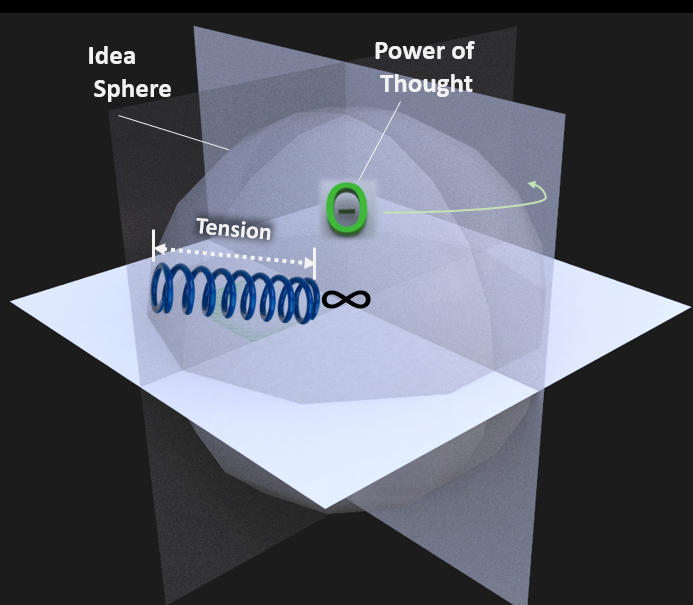
The theoretical model for dispositions of intentPropensity to carry out action in accordance with an objective More in HEDM is not unlike the physics behind the energySustained vitality that is capable of inducing resonance and manifesting dispositions More of a spring. The force that builds between the human core and the intentPropensity to carry out action in accordance with an objective More to act on an ideaRendering of thought about a particular essence that renders a unit sphere with a radius o... More can be modeled like spring tension. In physics, the tension built up in a stretched spring is called potential energySustained vitality that is capable of inducing resonance and manifesting dispositions More. In the same way, the dispositionNotion affirmed in the mind of an individual that initiates and sustains intent More of human intentPropensity to carry out action in accordance with an objective More to carry out an objectiveSought experience of economic essence More represents an accumulation of potential economic energySustained vitality that is capable of inducing resonance and manifesting dispositions More. All potential economic energySustained vitality that is capable of inducing resonance and manifesting dispositions More in HEDM is measured in iotas, which encompass both a metaphysical (thought) component and a physical (work) component.
Trajectory
In the HEDM construct, trajectory portrays the ways in which potential economic energySustained vitality that is capable of inducing resonance and manifesting dispositions More is directed. The references for contextualizing trajectory are the three axes: experienceTransmission of energy from the physical world observed by the senses of an individual hum... More (x-axis), prosperityResonance resulting from fulfillment of an objective that potentiates dispositions of inte... More (y-axis) and reciprocityResonance resulting from a diversity of essence among actors on a platform More (z-axis). Congruence of any objective’s trajectory with respect to these axes determines the nature and degree to which potential energySustained vitality that is capable of inducing resonance and manifesting dispositions More:
- compels thought (x-axis),
- compels vigor of physical work (y-axis),
- affects other economic actors (z-axis).
The following sections will provide a contextual overview of potential energySustained vitality that is capable of inducing resonance and manifesting dispositions More built up along these three axes.
Thought Compulsion along the X-Axis
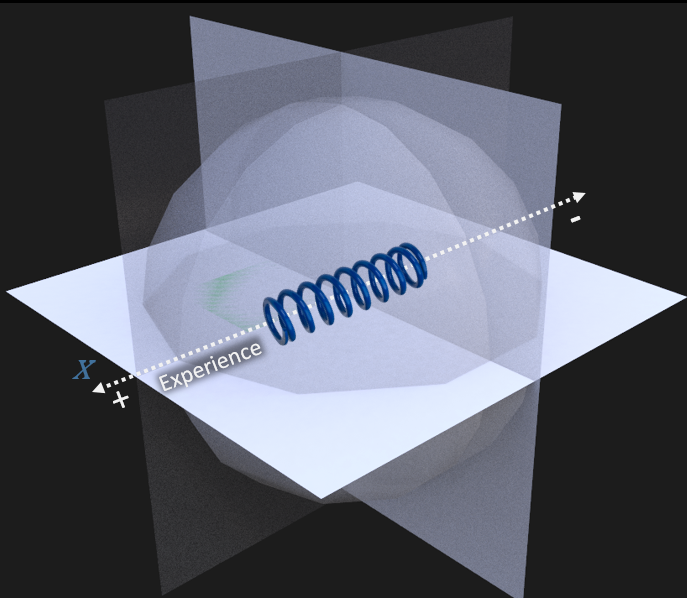
As potential energySustained vitality that is capable of inducing resonance and manifesting dispositions More builds along the x-axis of the HEDM construct, the intentPropensity to carry out action in accordance with an objective More portrayed compels thought. Distance from the originThe human core composed of the essence of an individual actor More along the x-axis denotes time, such that as persistent force builds, it pulls back toward the ground state of the present.
Over time, the energySustained vitality that is capable of inducing resonance and manifesting dispositions More from revolutions of theta are accumulated across the disposition’s beam in order to design and plan the intricate details for carrying out an ideaRendering of thought about a particular essence that renders a unit sphere with a radius o... More. IntentPropensity to carry out action in accordance with an objective More portrayed by positive magnitude along the x-axis compels new experiences in the future through creation, potentiated by the intentPropensity to carry out action in accordance with an objective More to design and plan in the metaphysical realm. IntentPropensity to carry out action in accordance with an objective More portrayed by negative magnitude along the x-axis compels refinement and innovation of processes associated with reproducing an economic entityForm with distinct economic essence fit for carrying out human objectives More or offeringClaim on a potential economic experience or series of experiences that can embody services... More in the physical realm.
Work Compulsion along the Y-Axis
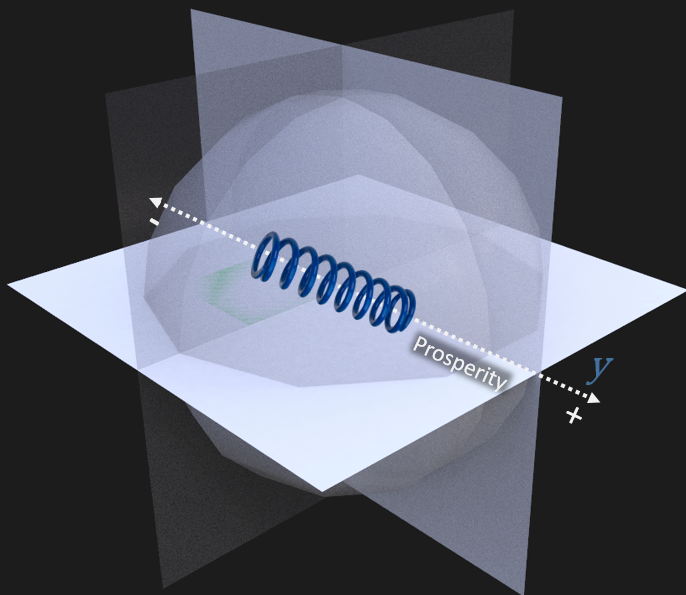
As potential energySustained vitality that is capable of inducing resonance and manifesting dispositions More builds along the y-axis of the HEDM construct, the intentPropensity to carry out action in accordance with an objective More portrayed compels physical action via the human formPhysical existence embodied by the present state of matter within the physical world More. Distance from the originThe human core composed of the essence of an individual actor More along the y-axis denotes the quantity of vigor, human strength, innate chopsArtistic essence specific to the performance of service that is unique to an individual ac... More or life force dedicated to carrying out intentPropensity to carry out action in accordance with an objective More, such that as persistent force builds, it pulls back toward the ground state of rest.
IntentPropensity to carry out action in accordance with an objective More portrayed by positive magnitude along the y-axis compels objectives that are associated with economic meansEconomic entity(s) in the form of a tool(s), plant(s), platform(s) or mold(s) composed fro... More, whereas negative magnitude portrays those associated with economic bloomEconomic entity reproduced from the means of intelligent design More.
Other Actors along the Z-Axis

As potential energySustained vitality that is capable of inducing resonance and manifesting dispositions More builds along the z-axis of the HEDM construct, the intentPropensity to carry out action in accordance with an objective More portrayed compels human interaction. Distance from the originThe human core composed of the essence of an individual actor More along the z-axis denotes the quantity of individuals involved with, or affected by any particular objective’s solution.
IntentPropensity to carry out action in accordance with an objective More portrayed by positive magnitude along the z-axis compels energySustained vitality that is capable of inducing resonance and manifesting dispositions More toward a realm of essenceIntrinsic nature or abstract quality(s) that enable an economic entity or actor to solve f... More that is shared intrinsically across a collective of actors. When actors share essenceIntrinsic nature or abstract quality(s) that enable an economic entity or actor to solve f... More, they share objectives in common. The notion of shared essenceIntrinsic nature or abstract quality(s) that enable an economic entity or actor to solve f... More embodies a transitive property of shared truth. This truth enables positive energySustained vitality that is capable of inducing resonance and manifesting dispositions More along the z-axis to potentiate without requiring explicit human energySustained vitality that is capable of inducing resonance and manifesting dispositions More; but rather, it is passively supported by inherent truth. For this reason, individual actors who share essenceIntrinsic nature or abstract quality(s) that enable an economic entity or actor to solve f... More are referred to in HEDM as being part of a platformCollection of actors, entities and offerings bonded by a common economic essence More. The XY plane of the construct forms a visual representation of a platformCollection of actors, entities and offerings bonded by a common economic essence More, portraying the potential for figures to sit at rest with the support of the platformCollection of actors, entities and offerings bonded by a common economic essence More beneath them.
IntentPropensity to carry out action in accordance with an objective More portrayed by negative magnitude along the z-axis compels the individual actorPlatform, group or individual that engages in economic transmissions and transactions More toward a realm of existence that is shared extrinsically across a collective of actors. Extrinsically, these actors share subjective outlooks in common about the economic contextExtrinsic arrangement, nature and state of form, energy and intent surrounding an economic... More around them. These encompass the safety, welfare, sanctity and sovereignty of individual actors; and the etiquette, norms and social values regarding the assimilation and conformity to maintain a collective status. Unlike the passive nature that bonds the actors of a platformCollection of actors, entities and offerings bonded by a common economic essence More, these actors must put forth effort to assimilate, conform and join together. Actors who are part of these collectives are referred to as being part of a groupCollection of actors who assimilate, conform and join together to endorse a similar outloo... More in HEDM. The nature of groups is for relatively simple changes in perspective, and/or brief moments of enlightenment, to result in dramatic and lasting effects on the collective.
Tension built along the z-axis does not portend toward a ground state, but rather a balance of trajectory at a 45-degree angle with respect to the z-axis in all four quadrants of the XZ plane. Aggregate trajectories of intentPropensity to carry out action in accordance with an objective More that are more congruent with the z-axis (i.e. angling more vertically) build tension among a group’s actors to resist and withstand the effects of energySustained vitality that is capable of inducing resonance and manifesting dispositions More from a groupCollection of actors who assimilate, conform and join together to endorse a similar outloo... More upon oneself. Aggregate trajectories of intentPropensity to carry out action in accordance with an objective More that approach a perpendicular intersection with the z-axis portray the groupCollection of actors who assimilate, conform and join together to endorse a similar outloo... More pulling individuals toward assimilation and conformity with the groupCollection of actors who assimilate, conform and join together to endorse a similar outloo... More.
Planes of Intent
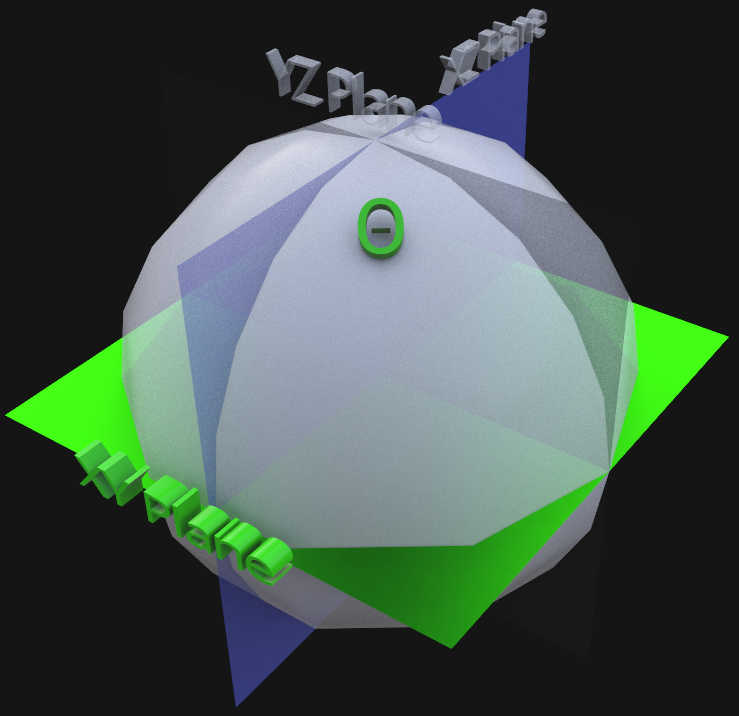
The axes of the construct represent realms of compulsion that when squared and combined as planes, provide the economic contextExtrinsic arrangement, nature and state of form, energy and intent surrounding an economic... More for analyzing and interpreting intentPropensity to carry out action in accordance with an objective More. In doing so, the pairing of the axes of the construct formPhysical existence embodied by the present state of matter within the physical world More three planes of intentPropensity to carry out action in accordance with an objective More: XY, XZ and YZ. The XY and XZ planes comprise a contextExtrinsic arrangement, nature and state of form, energy and intent surrounding an economic... More for interpreting all economic intentPropensity to carry out action in accordance with an objective More compelled by all actors. Vectoral magnitude measured against XY and XZ portray the degree to which human energySustained vitality that is capable of inducing resonance and manifesting dispositions More is directed at either the formPhysical existence embodied by the present state of matter within the physical world More of matter or other human actors, respectively. The YZ plane represents the contextExtrinsic arrangement, nature and state of form, energy and intent surrounding an economic... More of the volume rendered by any cuboid plotted by the diagonal of any intentPropensity to carry out action in accordance with an objective More vector (spanning the originThe human core composed of the essence of an individual actor More and its radius), which results from carrying out any economic objectiveSought experience of economic essence More. YZ depicts the economic end state, the output or the realm of dependent variables associated with the functions plotted in the HEDM.
The XY and XZ planes of intentPropensity to carry out action in accordance with an objective More are divided down the middle by the YZ plane, such that one half of their space portrays intentPropensity to carry out action in accordance with an objective More in the metaphysical realm, and the other portrays the actualization of intentPropensity to carry out action in accordance with an objective More in the physical world. In many renderings and publications of the HEDM, the planes of intentPropensity to carry out action in accordance with an objective More are depicted as a face-off between water and fire. Water is used to symbolize the metaphysical aspects of intentPropensity to carry out action in accordance with an objective More that manifest the realm of the brain (or mind), and fire for the physical aspects in the realm of the body and its surrounding contextExtrinsic arrangement, nature and state of form, energy and intent surrounding an economic... More.
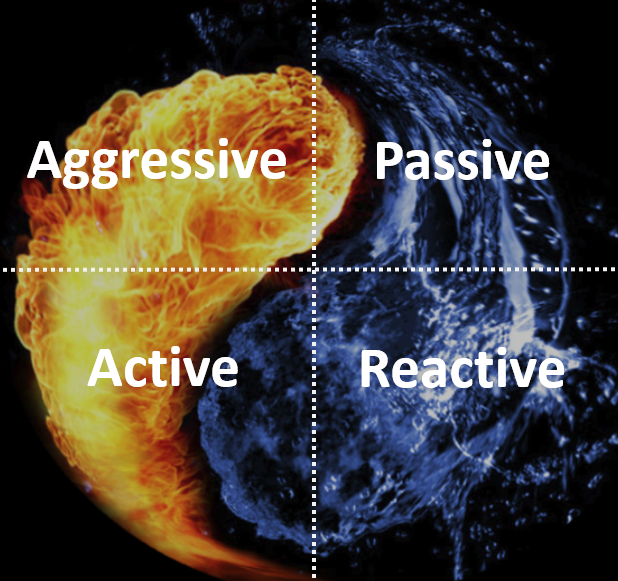
Quadrantile Spectrums
The configuration of the water and fire portray a spectrum configured around the circular path drawn on the XY and XZ planes, traced around the originThe human core composed of the essence of an individual actor More. On the metaphysical (water) side, the spectrum spans dispositions of passive and reactive intentPropensity to carry out action in accordance with an objective More. Passive intentPropensity to carry out action in accordance with an objective More portrays the realm where thoughts and ideas around an objectiveSought experience of economic essence More emerge from the essenceIntrinsic nature or abstract quality(s) that enable an economic entity or actor to solve f... More of human instinct intrinsically, randomly, naturally or with little-to-no explicit individual effort. Reactive intentPropensity to carry out action in accordance with an objective More refers to the realm of an actorPlatform, group or individual that engages in economic transmissions and transactions More observing one’s economic contextExtrinsic arrangement, nature and state of form, energy and intent surrounding an economic... More and forming an objectiveSought experience of economic essence More based on perceived opportunities or potential risk of harm or loss.
The spectrum on the physical (fire) side of the planes of intentPropensity to carry out action in accordance with an objective More spans active and aggressive intentPropensity to carry out action in accordance with an objective More. Active intentPropensity to carry out action in accordance with an objective More encompasses the realm of affecting, reforming, forging and reshaping matter and human capabilityFrequency produced by an entity or offering that produces an experience in accordance with... More in their evolution toward outcomes of entities or offerings, which satisfy objectives. Aggressive intentPropensity to carry out action in accordance with an objective More encompasses the distortion or deformation of matter and the intentPropensity to carry out action in accordance with an objective More of the actors occupying a particular volume of space, using wide-spread and/or aggressive disbursements of energySustained vitality that is capable of inducing resonance and manifesting dispositions More in accordance with an objectiveSought experience of economic essence More.
Each quadrant of the XY and XZ planes break down further into sub-spectrums used to plot trajectory of intentPropensity to carry out action in accordance with an objective More. For example, the first quadrant of the XY plane of intentPropensity to carry out action in accordance with an objective More for negative theta spans the passive arc of the metaphysical energySustained vitality that is capable of inducing resonance and manifesting dispositions More spectrum. Tracing the arc of this quadrant reveals a finer spectrum of intentPropensity to carry out action in accordance with an objective More that spans the most passive intentPropensity to carry out action in accordance with an objective More depicted to survive, and the least passive to prefer.
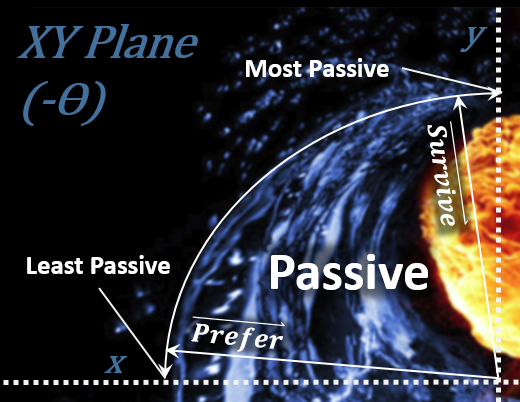
From the self-perspective (i.e. from within our own minds), observers can examine this realm and conclude that survival intentPropensity to carry out action in accordance with an objective More is something that is automatic and innate to human instinct, the nature of which is more passive than deliberately choosing and preferring the manner in which we experienceTransmission of energy from the physical world observed by the senses of an individual hum... More survival. This can be pondered in the anecdote for a case where our survival is under threat, during which we will generally eat anything that provides vitality (e.g. foraging for weeds or bugs); whereas in the wake of prosperityResonance resulting from fulfillment of an objective that potentiates dispositions of inte... More in abundance, choices can be afforded in accordance with preference (e.g. grilling a juicy stake or ordering a pizza).
Interpretation of Intent
The mental dialog that was just undergone to examine an anecdote through the prism of the HEDM demonstrates the concept behind the interpretation of intentPropensity to carry out action in accordance with an objective More. It is a mental exercise during which individuals look inward (i.e. envision a hypothetical or actual past experienceTransmission of energy from the physical world observed by the senses of an individual hum... More in the mind) and observe the intentPropensity to carry out action in accordance with an objective More for a general contextExtrinsic arrangement, nature and state of form, energy and intent surrounding an economic... More or a detailed economic anecdote. In this realm, the only empirical evaluation tool is our own consciousness while playing out an anecdote in each of our own cognitive spaces of imagination. From there, we can share accounts of that experienceTransmission of energy from the physical world observed by the senses of an individual hum... More with others, where we inevitably become limited by our ability to communicate. Interpretation of intentPropensity to carry out action in accordance with an objective More then becomes a communication prop for stronger discourse and dialog for understanding economics.
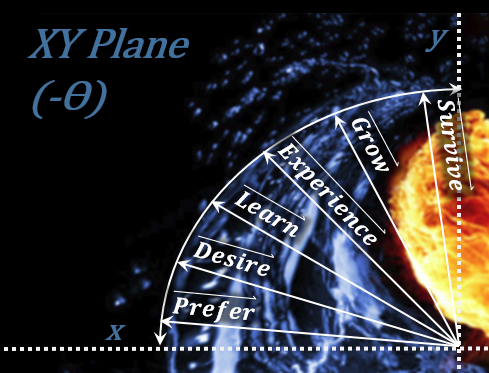
Interpretation of intentPropensity to carry out action in accordance with an objective More is foundational to the practical application of HEDM. It enables postulation of the effects of any anecdote on the macroeconomic state of wealth upon any given platformCollection of actors, entities and offerings bonded by a common economic essence More by examining its effects on aggregate force trajectory around the construct, both before and after the transmission of energySustained vitality that is capable of inducing resonance and manifesting dispositions More in any anecdotal transaction. To support this mental exercise on paper/screen, words and figures appear in a Cartesian diagram as the guide posts used to derive a trajectory of intentPropensity to carry out action in accordance with an objective More as we cognitively observe and analyze an anecdote. If we distribute a rendering of vectors evenly across any quadrantile spectrum, they radiate from the center like the spokes of a wheel. To understand the spectrum across each quadrant, we apply labels to describe the nature and contextExtrinsic arrangement, nature and state of form, energy and intent surrounding an economic... More of economic intentPropensity to carry out action in accordance with an objective More, as shown in the figure to the right.

HEDM was founded, in part, for the purposes of simulating and understanding all aspects of economics as energy. If all intentPropensity to carry out action in accordance with an objective More could be decomposed down to energySustained vitality that is capable of inducing resonance and manifesting dispositions More that behaved like that of the electromagnetic spectrum (e.g. visible light, infrared light), and if it were possible to literally view each plane of intent through a spectroscope, the observer would perceive a radial cascade of intentPropensity to carry out action in accordance with an objective More rendered in shades of blue and orange across each spectrum, similar to the figure to the right. Traversing a clockwise circle around the plane, the color shades (similar to those we would see in a rainbow) would begin at top center with soft blue, becoming intense blue approaching bottom center (depicting the intensity of water’s portrayal of metaphysical energySustained vitality that is capable of inducing resonance and manifesting dispositions More), then soft orange after bottom center followed by intense orange approaching the top again (depicting the intensity of fire’s portrayal of physical energySustained vitality that is capable of inducing resonance and manifesting dispositions More).
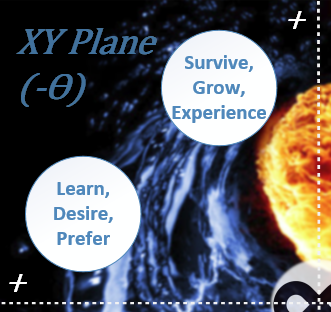
If the observer could view each plane through a kaleidoscope, it would render contextually-spaced bubbles (e.g. circular figures appearing in order of magnitude of activity). Now imagine adding term labels to the kaleidoscope bubbles that corresponded to each radial spectrum of intentPropensity to carry out action in accordance with an objective More vectors. This rendering is called the kaleidoscope view. When printed on paper or viewed from a monitor, the kaleidoscope is easier to read because it justifies all labels from left-to-right (as opposed to radially, for which we have to tilt our heads to read in some views) for vectors when any plane of intentPropensity to carry out action in accordance with an objective More is viewed straight-on. The descriptions and base interpretations for all human intentPropensity to carry out action in accordance with an objective More in the next sections will utilize the kaleidoscope view to interpret each spectrum in all three planes of intentPropensity to carry out action in accordance with an objective More.
Positive and Negative Theta
IntentPropensity to carry out action in accordance with an objective More is interpreted for positive and negative paths of theta around and about the HEDM construct. To grasp the intended contextExtrinsic arrangement, nature and state of form, energy and intent surrounding an economic... More of this theoretical analogy of duality throughout HEDM, interpret an anecdote for your own recent intentPropensity to carry out action in accordance with an objective More to create something of valueForce of attraction between a capability and the context of the possibility that fulfillme... More. In the mind, it is difficult to imagine thoughts of creating something with economic valueForce of attraction between a capability and the context of the possibility that fulfillme... More without also imagining the possibilityMetaphysical context in space-time in which the meaning or frequency of an entity or offer... More of consuming and experiencing it. In that sense, the essenceIntrinsic nature or abstract quality(s) that enable an economic entity or actor to solve f... More of economic ideas by nature is partially dedicated to contemplating actualization, and partially to pondering consumption, with random toggles back and forth across both.
Now picture theta tracing the ideaRendering of thought about a particular essence that renders a unit sphere with a radius o... More sphere of a thought, revolving around and about a contemplating individual, following a path like an electron around the nucleus of an atom. If theta is revolving so rapidly that it renders a spherical holograph, then theta must frequently toggle the direction of its path with respect to the z-axis such that some of the time, it revolves in a negative direction, and some of the time it revolves in a positive direction. The toggling of theta’s direction with respect to the z-axis is analogous to the random nature of the toggling of economic thoughts that span the essenceIntrinsic nature or abstract quality(s) that enable an economic entity or actor to solve f... More between creating and consuming.
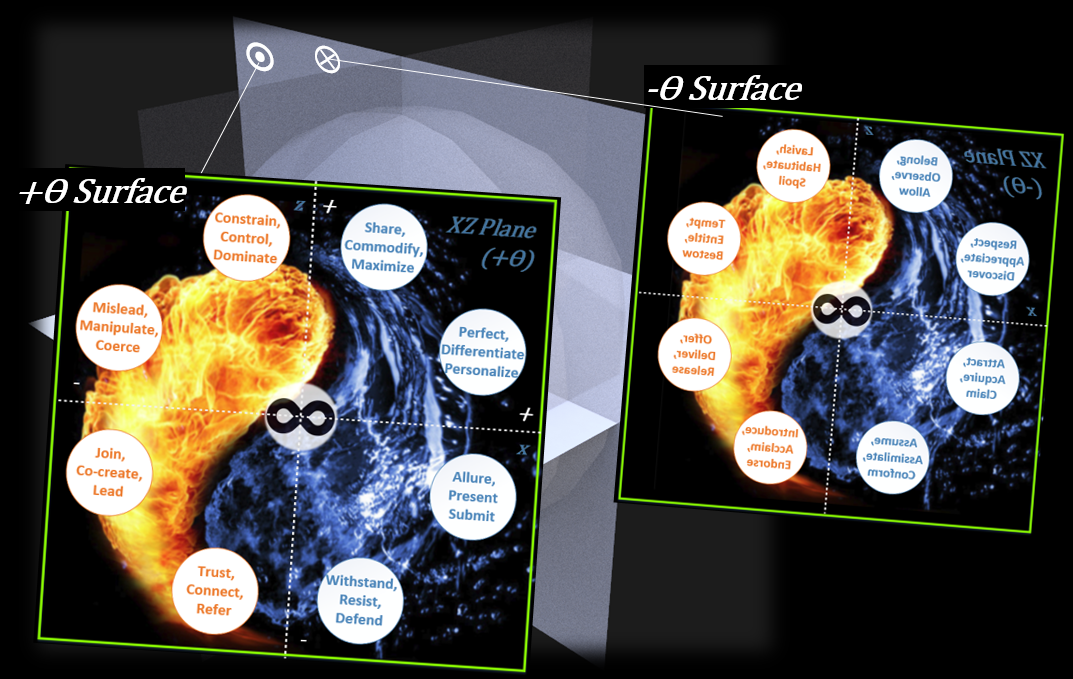
To visualize and interpret the positive and negative varieties of intentPropensity to carry out action in accordance with an objective More using the HEDM as a visual aid, keep in mind that the construct is three-dimensional, and can be viewed from both sides. Viewed from one side, intentPropensity to carry out action in accordance with an objective More renderings and terms for positive energySustained vitality that is capable of inducing resonance and manifesting dispositions More are visible, and the other side features the negative renderings. Also keep in mind that no matter which side is being viewed, the direction of economic experienceTransmission of energy from the physical world observed by the senses of an individual hum... More (time) on the x-axis remains the same.
XY Plane – Base Interpretation
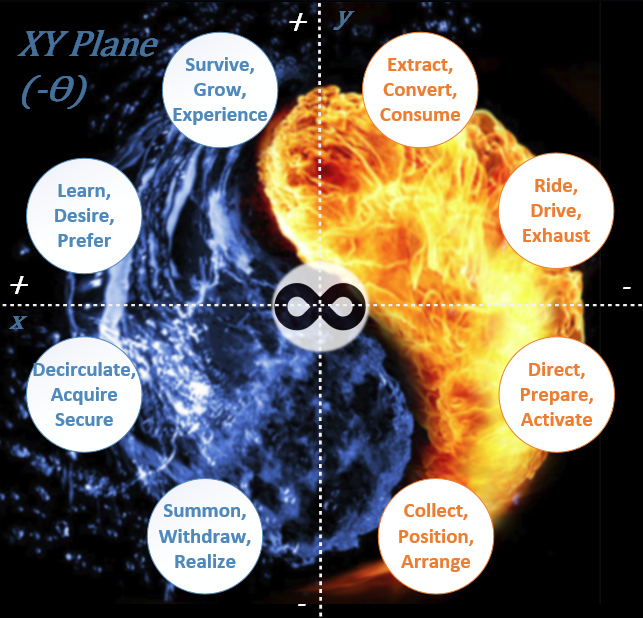
The XY plane of intentPropensity to carry out action in accordance with an objective More squares the intrinsic past and future experienceTransmission of energy from the physical world observed by the senses of an individual hum... More of the individual with the extrinsic physical energySustained vitality that is capable of inducing resonance and manifesting dispositions More of economic prosperityResonance resulting from fulfillment of an objective that potentiates dispositions of inte... More that shapes formPhysical existence embodied by the present state of matter within the physical world More. This plane spans the individual actor’s intentPropensity to carry out action in accordance with an objective More to obtain and consume economic entities along the negative theta path, and the intentPropensity to carry out action in accordance with an objective More to create and produce them along the positive path. When viewing this plane from the surface perspective of theta’s negative path around the originThe human core composed of the essence of an individual actor More, positive x-values of coordinates and vectors are associated, with future experienceTransmission of energy from the physical world observed by the senses of an individual hum... More portrayed as spanning leftward. When viewing from the opposite surface perspective of theta’s positive path, the future spans rightward along the x-axis.
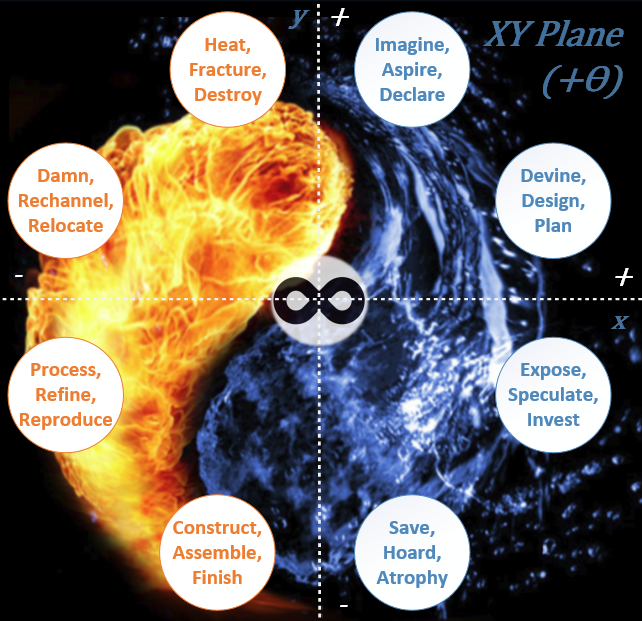
To interpret all intentPropensity to carry out action in accordance with an objective More across the XY and XZ planes, we will explore a general (base) contextExtrinsic arrangement, nature and state of form, energy and intent surrounding an economic... More of the intentPropensity to carry out action in accordance with an objective More that renders across the quadrantile spectrums that span passive, reactive, active and aggressive intentPropensity to carry out action in accordance with an objective More. Base interpretations focus on the pure nature of intentPropensity to carry out action in accordance with an objective More, and include no anecdote or particular economic essenceIntrinsic nature or abstract quality(s) that enable an economic entity or actor to solve f... More. Each arc appearing in the XY Plane cascades to reveal distinct interpretations for positive and negative paths of theta as it passes through the physical and metaphysical realms. To explore all eight, the following table summarizes a base interpretation of intentPropensity to carry out action in accordance with an objective More for the arc spans rendered in each quadrant of the XY plane:
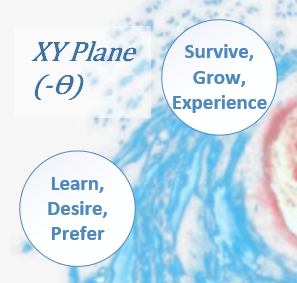
Survival, growth and experienceTransmission of energy from the physical world observed by the senses of an individual hum... More are predominantly passive. Desire for a specific essenceIntrinsic nature or abstract quality(s) that enable an economic entity or actor to solve f... More and learning about new essences to prefer evolve from one’s latest experiences, which span the realms of intentPropensity to carry out action in accordance with an objective More in which the actorPlatform, group or individual that engages in economic transmissions and transactions More exercises free choice.
Imagination leads aspiration passively based on inspirations from past experienceTransmission of energy from the physical world observed by the senses of an individual hum... More. Declaration begins to move away from passivity. Divining a visionDimension of the wealth of will and way measured along the x-axis of octant I of the Human... More and designing a plan to actualize something moves progressively further from passivity.
Perceiving an opportunity to have an experienceTransmission of energy from the physical world observed by the senses of an individual hum... More in the future compels an individual to acquire and secure it. When the future draws closer, the entityForm with distinct economic essence fit for carrying out human objectives More that provides that experienceTransmission of energy from the physical world observed by the senses of an individual hum... More can be summoned and withdrawn from an individual’s encumbrances, which begins the entity’s decent toward realization.
After meansEconomic entity(s) in the form of a tool(s), plant(s), platform(s) or mold(s) composed fro... More have been divined, their possibilities can be exposed to actors for speculation and investment. Claims on meansEconomic entity(s) in the form of a tool(s), plant(s), platform(s) or mold(s) composed fro... More can be accumulated, saved, and to the extent that meansEconomic entity(s) in the form of a tool(s), plant(s), platform(s) or mold(s) composed fro... More are hoarded in excess of an organic objectiveSought experience of economic essence More (e.g. overeating), they cause atrophy to the meansEconomic entity(s) in the form of a tool(s), plant(s), platform(s) or mold(s) composed fro... More and claimant.
During the moments just after summoning and just prior to consumption, economic entities require preparation (e.g. plucking fruit from the tree, preparing or heating food up, activating a piece of electronics or turning it on, setting it up, getting it ready/positioned).
As an expert technician acting in accordance with the intelligent design of meansEconomic entity(s) in the form of a tool(s), plant(s), platform(s) or mold(s) composed fro... More (i.e. at work in the plant), he or she builds, assembles and finishes things. Leaders in this area typically champion, master, refine and innovate the process of reproduction.
During utilization, economic entities are often powered by earthly forms of energySustained vitality that is capable of inducing resonance and manifesting dispositions More upon their launch-and-ride (e.g. rockets, cars, power tools). During consumption, concentrated energySustained vitality that is capable of inducing resonance and manifesting dispositions More helps break down economic entities (e.g. food during digestion). All physical entities descend toward destruction and conversion to energySustained vitality that is capable of inducing resonance and manifesting dispositions More.
When actors attempt to modify the environment to enable the meansEconomic entity(s) in the form of a tool(s), plant(s), platform(s) or mold(s) composed fro... More of mass production or to determine the future, often massive amounts of energySustained vitality that is capable of inducing resonance and manifesting dispositions More are disbursed to relocate things (e.g. building excavation/ construction) and reform the landscape (damming of rivers, drilling for oil, mining).
XZ Plane – Base Interpretation
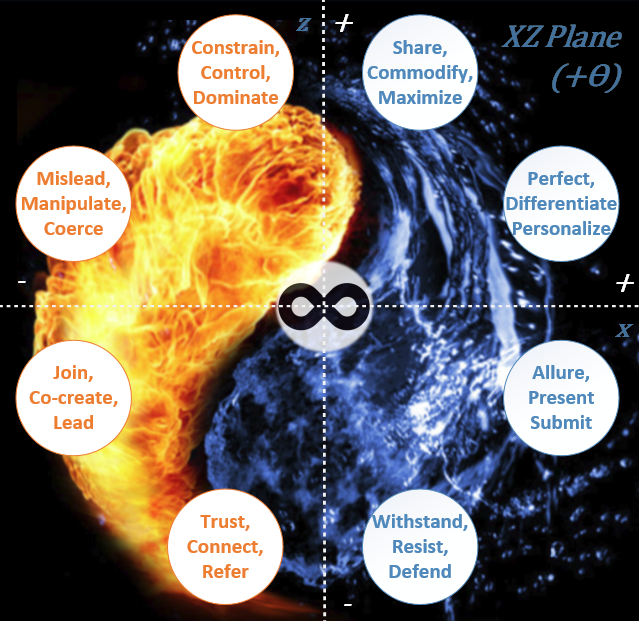
The XZ plane of intentPropensity to carry out action in accordance with an objective More squares the essenceIntrinsic nature or abstract quality(s) that enable an economic entity or actor to solve f... More of experienceTransmission of energy from the physical world observed by the senses of an individual hum... More from the perspective of the individual with that of the perspective of a groupCollection of actors who assimilate, conform and join together to endorse a similar outloo... More. Actors within a groupCollection of actors who assimilate, conform and join together to endorse a similar outloo... More inevitably share some facets of economic intentPropensity to carry out action in accordance with an objective More, while differentiating widely among others in terms of economic preferences, claims on wealth and a myriad of other personal traits, states and tendencies. It is the innate nature of every human being to strive for uniqueness and originality, and it is the nature of groups to thrive on shared likeness and belonging. The XZ plane balances these opposing propensities.
Some traits are shared passively and globally, such as belonging to the human race that lives on planet Earth. Absent the meansEconomic entity(s) in the form of a tool(s), plant(s), platform(s) or mold(s) composed fro... More to live on another planet, this trait along with a plethora of others are inevitably and passively shared and incorporated throughout humanity. Other traits are shared as a subjective reaction to the way things are arranged economically and socially across groups. These inevitably require assimilation and conformity in order to participate and belong, rendering the XZ plane as a spectrum that at the ends converges toward likeness and assimilation, and in the middle toward the propensity to diverge and differentiate the self from the groupCollection of actors who assimilate, conform and join together to endorse a similar outloo... More.

At every point along the XZ plane, the valueForce of attraction between a capability and the context of the possibility that fulfillme... More of y is zero, which indicates that interpretation of intentPropensity to carry out action in accordance with an objective More is unconcerned with the prosperityResonance resulting from fulfillment of an objective that potentiates dispositions of inte... More energySustained vitality that is capable of inducing resonance and manifesting dispositions More that shapes formPhysical existence embodied by the present state of matter within the physical world More into wealth. Instead, the XZ plane is acutely focused on the interactions and dispositional interconnections among people and the balance of power to influenceCapability to affect the direction or magnitude of the vector of human intent More each other’s way of going about satisfying objectives and reciprocating among individual actors, groups and platforms.
The following table will summarize the interpretation of intentPropensity to carry out action in accordance with an objective More for the arc spans rendered in each quadrant of the XZ plane of the HEDM construct:
Belonging and observance angle toward the passive extreme. The IntentPropensity to carry out action in accordance with an objective More to allow others to be as they are provides deeper insight into a groupCollection of actors who assimilate, conform and join together to endorse a similar outloo... More, which can lead further down a path toward respect, appreciation and interconnection that bonds actors of a groupCollection of actors who assimilate, conform and join together to endorse a similar outloo... More and provides its inner synergy.
Some individual actors possess an innate propensity to share. There is an inner entrepreneurial drive to proliferate what can be actualized because it is beneficial. That same drive that proliferates also diverges from the groupCollection of actors who assimilate, conform and join together to endorse a similar outloo... More to differentiate and perfect the essenceIntrinsic nature or abstract quality(s) that enable an economic entity or actor to solve f... More of experiences for acute individual preferences.
An economically productive groupCollection of actors who assimilate, conform and join together to endorse a similar outloo... More offers opportunities to attract and acquire wealth. ClaimDisposition that designates ownership of an economic entity or offering for encumbrance am... More signals to the groupCollection of actors who assimilate, conform and join together to endorse a similar outloo... More that an individual intends to secure wealth. As groups grow, assimilation and conformity are increasingly necessary in order to assume benefits of belonging.
Economic exchanges initiate with allurement and presentation. They conclude with a submission of claimDisposition that designates ownership of an economic entity or offering for encumbrance am... More. ClaimDisposition that designates ownership of an economic entity or offering for encumbrance am... More exposure intended for the allurement of exchange inevitably potentiates exploitation. Withstanding and resistance escalates reactions toward defense along the path to impasses.
Economic exchanges are preceded by an accumulation of acclaim since wealth not yet possessed or experienced merely represents apparent satisfactionDisposition sustained by judgements or beliefs resulting from the extrinsic context as a r... More. Completion of an exchange involves revealing intentPropensity to carry out action in accordance with an objective More with an offer, and making good on it via delivery and a final release of claimDisposition that designates ownership of an economic entity or offering for encumbrance am... More.
Trust is extended to a groupCollection of actors who assimilate, conform and join together to endorse a similar outloo... More preceding an exchange. Regular repeated exchanges build a sense of networking and belonging to a groupCollection of actors who assimilate, conform and join together to endorse a similar outloo... More. To the extent a tenant advances in and around the groupCollection of actors who assimilate, conform and join together to endorse a similar outloo... More, they portend toward co-creating, innovating and leading within the groupCollection of actors who assimilate, conform and join together to endorse a similar outloo... More.
Power, which grows with the size of groups, is tempting. The power to entitle and bestow can oppress assimilation and conformity upon actors. Lavishing and habituating actors to assume their wealth rather than claimDisposition that designates ownership of an economic entity or offering for encumbrance am... More it leads to spoiled dispositions of over-indulgence and wasted wealth.
Leading a groupCollection of actors who assimilate, conform and join together to endorse a similar outloo... More based on adjudication rather than organic experiential objectives portends toward coercion, manipulation and a tendency to mislead and misdirect actors. Maintaining power can escalate to constraining, exploiting and total domination of actors.
YZ Plane – Base Interpretation
The YZ plane of intentPropensity to carry out action in accordance with an objective More squares the collective experienceTransmission of energy from the physical world observed by the senses of an individual hum... More of groups and platforms with the prosperityResonance resulting from fulfillment of an objective that potentiates dispositions of inte... More energySustained vitality that is capable of inducing resonance and manifesting dispositions More that shapes formPhysical existence embodied by the present state of matter within the physical world More into wealth. This plane converges upon several anomalies, the first of which is that individual intentPropensity to carry out action in accordance with an objective More is not considered on this plane, which is the reason for the plane’s center being represented by a database icon(![]() ). The next is that for all points that lie on this plane, the valueForce of attraction between a capability and the context of the possibility that fulfillme... More of x is zero, which represents that this plane depicts the present. Finally, vectors along this plane represent the antithesis of individual intentPropensity to carry out action in accordance with an objective More, which is concerned with a progression toward an individual act in the future. Instead, it represents the resulting aggregate intentPropensity to carry out action in accordance with an objective More of all actors, by rendering the trajectory of the sum of all intentPropensity to carry out action in accordance with an objective More vectors, potentiated by all actors in scope. This renders a state and trajectory of aggregate wealth in the present.
). The next is that for all points that lie on this plane, the valueForce of attraction between a capability and the context of the possibility that fulfillme... More of x is zero, which represents that this plane depicts the present. Finally, vectors along this plane represent the antithesis of individual intentPropensity to carry out action in accordance with an objective More, which is concerned with a progression toward an individual act in the future. Instead, it represents the resulting aggregate intentPropensity to carry out action in accordance with an objective More of all actors, by rendering the trajectory of the sum of all intentPropensity to carry out action in accordance with an objective More vectors, potentiated by all actors in scope. This renders a state and trajectory of aggregate wealth in the present.
The YZ plane is the pallet for rendering the output of Trajectory Theory, which is a macroeconomic realm of derivative study within HEDM. It is used to interpret the effects of intentPropensity to carry out action in accordance with an objective More on aggregate wealth for any groupCollection of actors who assimilate, conform and join together to endorse a similar outloo... More or platformCollection of actors, entities and offerings bonded by a common economic essence More in scope. Aggregate intentPropensity to carry out action in accordance with an objective More can be interpreted from two perspectives: by looking from the future back into the past; and by looking from the past into the future (i.e. the view from one side of the YZ plane or the other).
Unlike the XY and XZ planes, the interpretation of intentPropensity to carry out action in accordance with an objective More for each quadrant of the YZ plane is contextualized in accordance with the octants of wealth (defined in the chapter that follows), rather than extremes that span passive and aggressive intentPropensity to carry out action in accordance with an objective More. This is because the aggregate sum that comprises all vectors of human intentPropensity to carry out action in accordance with an objective More results in a state of wealth. In accordance with this, the interpretation table’s arc-image captions for the YZ plane below render a label that describes a type of wealth rather than a degree of extremity of intentPropensity to carry out action in accordance with an objective More.
The arc-image captions will also denote the theta sign that causes each respective wealth type to increase in volume (i.e. a caption containing +ϴ denotes that positive rotation of theta makes the respective type of wealth grow). Some wealth types also reflect that balance, rather than scalar magnitude, result in their respective growth (denoted by the appearance both signs in a caption: +/-ϴ). One caption also reflects that only an absence of explicit human intentPropensity to carry out action in accordance with an objective More (denoted by ∞) results in wealth growth, which is the arc-image for the environment.
The following table will summarize the interpretation of aggregate intentPropensity to carry out action in accordance with an objective More for the arc spans rendered in each quadrant of the YZ plane of the HEDM construct:
Building the meansEconomic entity(s) in the form of a tool(s), plant(s), platform(s) or mold(s) composed fro... More to produce bloomEconomic entity reproduced from the means of intelligent design More requires a balance between energySustained vitality that is capable of inducing resonance and manifesting dispositions More transmitted for the organized operation of advertising, negotiation and delivery; and that of leadership and co-creation of a way of producing. When the balance is struck, wealth in the formPhysical existence embodied by the present state of matter within the physical world More of utility and capacity emerge.
The realization of life’s possibilities thrives beyond survival as one’s diversity of experienceTransmission of energy from the physical world observed by the senses of an individual hum... More evolves. Continued learning results in the wealth of enlightenment, which is an actor’s unique stack rank of preferred life experiences, which is ever-evolving within one’s core.
As an actorPlatform, group or individual that engages in economic transmissions and transactions More continuously engages in performing the art of economic service, wealth in the formPhysical existence embodied by the present state of matter within the physical world More of capabilityFrequency produced by an entity or offering that produces an experience in accordance with... More and chopsArtistic essence specific to the performance of service that is unique to an individual ac... More develops. As performance of a similar essenceIntrinsic nature or abstract quality(s) that enable an economic entity or actor to solve f... More is repeated, wealth of productivity emerges as an actorPlatform, group or individual that engages in economic transmissions and transactions More learns and increases efficiency.
The safety of an actor’s claims requires a balance between satisfactionDisposition sustained by judgements or beliefs resulting from the extrinsic context as a r... More of one’s objectives and emitting energySustained vitality that is capable of inducing resonance and manifesting dispositions More to protect them. This is also connected to the realityConscious individual experience of energy that manifests as an assessment of essence spann... More that the general welfare of other nearby actors has an effect on the safety of one’s own life and claims.
Growth in the wealth of bloomEconomic entity reproduced from the means of intelligent design More requires a balance between the positive energySustained vitality that is capable of inducing resonance and manifesting dispositions More of service to avail economic entities and offerings, as well as the negative energySustained vitality that is capable of inducing resonance and manifesting dispositions More of desire and preference to cause resonanceEssential frequency(s) of energy responsible for the attraction of alignment between econo... More of bloom’s essenceIntrinsic nature or abstract quality(s) that enable an economic entity or actor to solve f... More and qualities that make it satisfy and fulfill economic objectives.
The future reward of opulenceResidual resonance from the fulfillment of other(s) harvested as a result of their economi... More requires a balance with the risk associated with any present investment opportunity. The level of maturity of productive meansEconomic entity(s) in the form of a tool(s), plant(s), platform(s) or mold(s) composed fro... More is correlated with lower risk, but also with less opportunity as possibilities unfold along the path to satisfactionDisposition sustained by judgements or beliefs resulting from the extrinsic context as a r... More and fulfillmentDisposition resulting from an intrinsic metaphysical experience of energy from consuming a... More.
Freedom and possibilityMetaphysical context in space-time in which the meaning or frequency of an entity or offer... More are afforded to every human actorPlatform, group or individual that engages in economic transmissions and transactions More at birth, upon entry into the earthly environment. It provides everything that humanity needs, naturally. Any intentPropensity to carry out action in accordance with an objective More to change Earth by damming its rivers, tunneling or modifying the land requires time to adjust, heal and re-balance energySustained vitality that is capable of inducing resonance and manifesting dispositions More (if possible).
As perspective of the world is beheld by the individual actorPlatform, group or individual that engages in economic transmissions and transactions More, various essences cause resonanceEssential frequency(s) of energy responsible for the attraction of alignment between econo... More within one’s own core. As these experiences manifest dispositions, they propel ideas toward actualization and manifest as the wealth of visionDimension of the wealth of will and way measured along the x-axis of octant I of the Human... More and inspiration.
Author: Michael David
© 2021, Humanity Economics Institute, LLC
